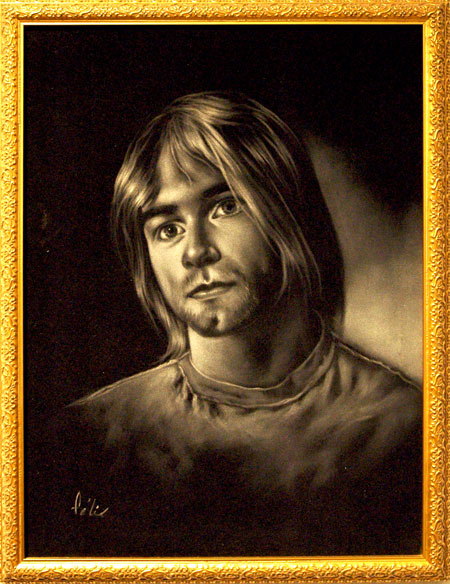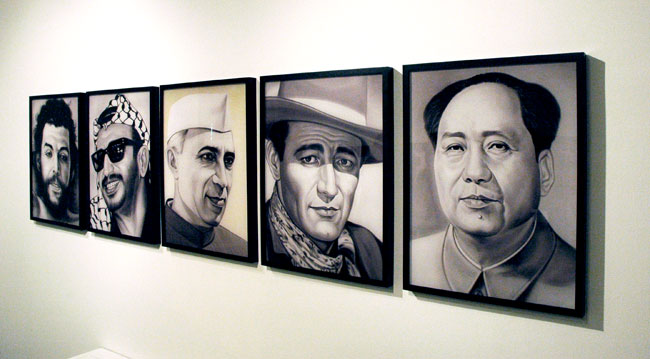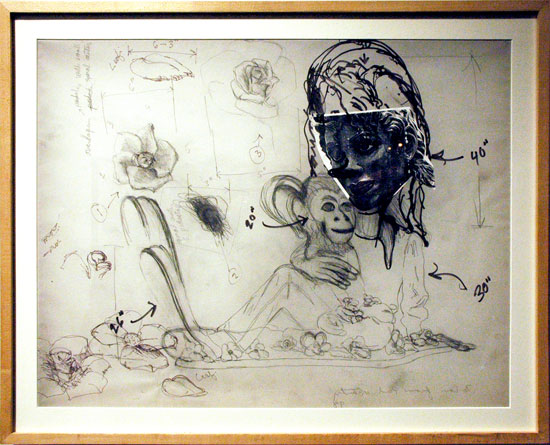
portrait of Kurt Cobain, by an anonymous artist, from a collection of paintings on velvet

Yasser Aggour's photographs of portraits commissioned of Cairo sign painters

detail of a section of Jennifer Dalton's "What Does an Artist Look Like?" captured from three years of The New Yorker

Paul McCarthy's drawing referencing Michael Jackson and Bubbles through Jeff Koons
Portraiture isn't what it used to be; or is it? Maybe it's just the times; the times, they just aren't what they used to be either.
SoHo's Carriage Trade gallery opened its exhibition, "The Cult of Personality, Portraits and Mass Culture", this past Thursday. An auspicious inaugural show, it uses portraiture as a means to examine the way in which our myths are assembled and deconstructed, specifically marking the similarity between the the myths which create, sustain and dim celebrities (and the products they sell) and those which generate, underpin and erode governments (and the policies they pursue).
An excerpt from the press release elaborates:
The process of crafting present-day myths to be served up for the purpose of turning the news into entertainment requires some belief in charismatic personalities. While the concept of a cult of personality is most often associated with autocratic leaders who use mass media to develop and sustain their popularity in an undemocratic state, the sphere of influence enjoyed by the media within a democratic system, and recent cases of its manipulation by government, suggest that this concept is ready for an expanded definition.I was totally smitten with the one piece I couldn't find on the gallery list. It's the black and white painting on velvet to the left just before you reach the desk. I had no idea who had created it (and as it turns out, nobody knows, including artist and gallery director Peter Scott), but maybe I was one of the few people in the room who had no idea whose portrait it was. Okay, Scott told me it represents Kurt Cobain, but how was I to know Cobain was beautiful even as a child? The work itself may or may not really be a part of the show. Although it's signed "Felix", it's by an artist whose name is apparently unknown even to its owner, WFMU's Station Manager Ken Freedman. It was purchased in Tijuana, from the painter.In adopting the genre of portraiture, a form associated with traditional identity construction which focuses on the relative psychological interest of the subject, The Cult of Personality, Portraits and Mass Culture attempts to locate the manner in which the development of an identity for mass consumption adopts the traditional viewer/subject relationship, often with the expectation that viewer will lose themselves in the protectiveness or superiority of the subject while finding momentary fulfillment in a distraction from what they are meant to feel that they lack.
. . . .
In the run up to an election which is mercifully overshadowing our current leaders long, slow decline in popularity, the mechanisms through which personality can trump reason in the public sphere might be worth revisiting, if only as a reminder of the very real consequences of allowing fictions to displace facts.
Popular commercial art, whether produced on commissioned or speculation, is a concept and a subject worthy of a serious book itself, and my apologies to the responsible parties if I'm overlooking the effort(s) of anybody who's already gone there.
Scott has put on a wonderful show. There are a relatively modest number of works involved, but this provocative and compelling curatorial project enjoys the additional interest which their broad diversity of medium, sophistication and approach provides.
The artists in the show whose work is not shown in the images above are Ligarno/Reese, Karen Yama, Vitaly Komar, Sherrie Levine, Muntadas and Reese, Julia Wachtel and Bill Owens.